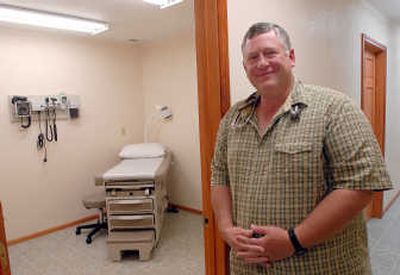Medical clinic opens in Athol

ATHOL – The rumble of hot-rod motors has been silenced in the old machine shop on state Highway 54 in Athol. In its place, physician assistant Chris Sundquist has fashioned three serene exam rooms, a lab station and an X-ray area – and left behind some of his own sweat and muscle.
Since deciding to turn the 1,400-square-foot shop into a medical clinic, the Sandpoint native has transformed the space to bring medical care closer to some of Idaho’s rural residents.
In between wielding his paintbrush and touching up drywall, Sundquist met a couple of nearby residents who stopped by before he officially opened for business this week.
One had fallen from a roof; another had suffered a table-saw injury. Both were looking for immediate, convenient help.
“Those are things we can take care of,” Sundquist said.
The new practice, Timberlake Family Medicine, opened Monday.
Its name represents the broad area that Sundquist hopes to reach. Athol, about 30 minutes from the nearest hospital, is included in the Timberlake fire and school districts, where northern Kootenai County meets southern Bonner County. Besides Athol’s 700 residents, Sundquist hopes communities near Bayview, Silverwood Theme Park and Farragut State Park will take advantage of his “close-to-home” services.
A bare-bones staff – a receptionist and a phlebotomist in addition to Sundquist – will operate the office.
Idaho allows physician assistants to open independent clinics as long as a physician is available for consultation and a monthly site review. Sundquist will rely on Dr. Robert Rust of Sandpoint Family Medicine for his supervision.
He has known Rust for many years, first as his family physician and friend and more recently as an employer.
Sundquist says he knows of no other clinic owned and operated by a physician assistant in North Idaho, and he believes they are few and far between throughout the state.
Sundquist decided to open his own office in part because he could generate increased revenue by working for himself and also because he has an admitted preference for doing things “my way.”
Sundquist says he developed a taste for working independently while serving as a Navy hospital corpsman for 13 years. Joining the Navy after earning a forestry degree at North Idaho College, he found himself on submarines and destroyers in ports around the globe and was responsible for the well-being of 350 sailors.
“You’d be their doctor, counselor and pastor,” he said.
Sundquist’s responsibilities were similar to the duties of a physician assistant, which prompted him to pursue the career as a civilian.
“I already knew how to suture, look at X-rays and write prescriptions,” he said.
Sundquist says he discovered his love for rural medicine with his first physician assistant position after receiving a master’s degree from Idaho State University in 1998. He worked in Council, Idaho, a town 300 miles south of Athol with a similar population.
“There are more wolves and elk there than people, some say,” he said.
Sundquist returned to North Idaho to be closer to his parents, Gordon and Irene, longtime Sandpoint residents.
Chris Sundquist is a 1979 Sandpoint High School graduate and has two children in their 20s. He keeps a sailboat at a Bayview marina, which is a quick drive from his new clinic, and also enjoys mountain biking, cross-country skiing and fishing.
In choosing Athol, Sundquist believes he has found a population that can benefit from his emphasis on preventive health screenings, management of chronic illnesses and early diagnosis of disease.
The area is home to about 70 percent Medicare, Medicaid and military beneficiaries, who traditionally avoid routine screenings or medical intervention until a crisis occurs. He is partnering with Spokane’s Sacred Heart Medical Center to bring mobile mammography to the clinic every two to four weeks.
“In rural communities, people don’t go to the hospital and don’t go to the doctor unless they have to,” Sundquist said. “Earlier detection of chronic illnesses would give them a better quality of life.”
Other clinics place limits on the number of Medicare and Medicaid patients. Sundquist says his advantage as a physician assistant is that he can apply for federal designation as a rural health clinic, allowing for increased reimbursement rates and enabling the clinic to accept more Medicare and Medicaid patients.
“To receive that (federal designation), you have to be in an area that is medically underserved, and you have to have a physician assistant or nurse practitioner on staff at least half time,” he said.
Sundquist says he expects to offer services such as suturing, casting, well women’s checks, children’s exams and occupational medicine.
“I feel I make a bigger difference in a smaller community,” Sundquist said. “It’s the flavor of medicine I like to practice and the type of people I like to be around.”